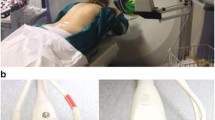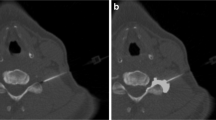Abstract
Objectives
To investigate injectate dispersal patterns and their association with therapeutic efficacy during a transforaminal (TFSI) or an intra-articular facet steroid injection (IFSI) to treat cervical radiculopathy.
Methods
This retrospective study examined the post-intervention cervical spine CT of 56 patients randomized to receive one CT fluoroscopy–guided IFSI (29 patients; 10 (34.5%) males; mean age 45.0 years; SD 8.8 years; range 26–61 years) or TFSI (27 patients; 13 (48.2%) males; mean age 51.1 years; SD 11.2 years; range 29–72 years) (December 2010 to August 2013). The presence of contrast within the intra-articular facet, juxta-articular facet, retrodural, epidural, and foraminal and extraforaminal spaces during IFSI, and within the extraforaminal, foraminal, and epidural spaces during TFSI was assessed. Descriptive data are presented as frequencies. The association between injectate dispersal patterns and therapeutic efficacy, 4-week post-intervention, was assessed with ANCOVA models.
Results
During IFSI, the injectate predominantly spread to the retrodural (62%; 18/29) or juxta-articular (21%; 6/29) space. During TFSI, the injectate predominantly spread to the extraforaminal/foraminal spaces (41%; 11/27) or to the extraforaminal/foraminal/epidural spaces (33%; 9/27). Injectate presence in the juxta-articular (p = .007) or extraforaminal (p < .001) space was a predictor of therapeutic efficacy but not in the foraminal (p = .54), epidural (p = .89), or retrodural (p = .75) space.
Conclusions
TFSI and IFSI led to preferential extraforaminal and retrodural injectate spread, respectively. Targeting the extraforaminal or juxta-articular facet space improved the clinical efficacy of steroid injections when treating cervical radiculopathy.
Key Points
• During intra-articular facet injection, the injectate spreads from the facet joint to the retrodural space and rarely reaches the epidural and/or foraminal spaces.
• Epidural spread of the injectate during an anterolateral transforaminal steroid injection is the least effective for pain relief in patients with cervical radiculopathy.
• Injection techniques targeting the extraforaminal or juxta-articular facet space are safer than transforaminal injections and effectively relieve pain in patients with cervical radiculopathy.






Similar content being viewed by others
Abbreviations
- IFSI:
-
Intra-articular facet steroid injection
- TFSI:
-
Transforaminal steroid injection
- VAS:
-
Visual analog scale
- VAS%:
-
Relative difference between baseline and 4-week post-intervention VAS pain scores
References
Carette S, Fehlings MG (2005) Clinical practice. Cervical radiculopathy. N Engl J Med 353(4):392–399
Heckmann JG, Lang CJ, Zobelein I, Laumer R, Druschky A, Neundorfer B (1999) Herniated cervical intervertebral discs with radiculopathy: an outcome study of conservatively or surgically treated patients. J Spinal Disord 12(5):396–401
Saal JS, Saal JA, Yurth EF (1996) Nonoperative management of herniated cervical intervertebral disc with radiculopathy. Spine (Phila Pa 1976) 21(16):1877–1883
Cyteval C, Thomas E, Decoux E et al (2004) Cervical radiculopathy: open study on percutaneous periradicular foraminal steroid infiltration performed under CT control in 30 patients. AJNR Am J Neuroradiol 25(3):441–445
Lasbleiz J, Siegfried D, Chales G, Marin F, Sighetti M, Duvauferrier R (2008) Evaluation of CT guided cervical epidural injections in patients with mechanical cervicobrachial neuralgia. J Radiol 89(3 Pt 1):317–323
Vallee JN, Feydy A, Carlier RY, Mutschler C, Mompoint D, Vallee CA (2001) Chronic cervical radiculopathy: lateral-approach periradicular corticosteroid injection. Radiology 218(3):886–892
Derby R, Lee SH, Kim BJ, Chen Y, Seo KS (2004) Complications following cervical epidural steroid injections by expert interventionalists in 2003. Pain Physician 7(4):445–449
Lee JW, Hwang SY, Lee GY, Lee E, Kang HS (2014) Fluoroscopic cervical paramidline interlaminar epidural steroid injections for cervical radiculopathy: effectiveness and outcome predictors. Skeletal Radiol 43(7):933–938
Hoang JK, Massoglia DP, Apostol MA, Lascola CD, Eastwood JD, Kranz PG (2013) CT-guided cervical transforaminal steroid injections: where should the needle tip be located? AJNR Am J Neuroradiol 34(3):688–692
Scanlon GC, Moeller-Bertram T, Romanowsky SM, Wallace MS (2007) Cervical transforaminal epidural steroid injections: more dangerous than we think? Spine (Phila Pa 1976) 32(11):1249–1256
Anderberg L, Annertz M, Persson L, Brandt L, Saveland H (2007) Transforaminal steroid injections for the treatment of cervical radiculopathy: a prospective and randomised study. Eur Spine J 16(3):321–328
Provenzano DA, Fanciullo G (2007) Cervical transforaminal epidural steroid injections: should we be performing them? Reg Anesth Pain Med 32(2):168 author reply 169-170
Rathmell JP, Benzon HT (2004) Transforaminal injection of steroids: should we continue? Reg Anesth Pain Med 29(5):397–399
Wolter T, Knoeller S, Berlis A, Hader C (2010) CT-guided cervical selective nerve root block with a dorsal approach. AJNR Am J Neuroradiol 31(10):1831–1836
Wald JT, Maus TP, Geske JR et al (2012) Safety and efficacy of CT-guided transforaminal cervical epidural steroid injections using a posterior approach. AJNR Am J Neuroradiol 33(3):415–419
Bensler S, Sutter R, Pfirrmann CW, Peterson CK (2015) Long term outcomes from CT-guided indirect cervical nerve root blocks and their relationship to the MRI findings--a prospective study. Eur Radiol 25(11):3405–3413
Sutter R, Pfirrmann CW, Zanetti M, Hodler J, Peterson CK (2011) CT-guided cervical nerve root injections: comparing the immediate post-injection anesthetic-related effects of the transforaminal injection with a new indirect technique. Skeletal Radiol 40(12):1603–1608
Bise S, Pesquer L, Feldis M et al (2018) Comparison of three CT-guided epidural steroid injection approaches in 104 patients with cervical radicular pain: transforaminal anterolateral, posterolateral, and transfacet indirect. Skeletal Radiol 47(12):1625–1633
Bureau NJ, Moser T, Dagher JH et al (2014) Transforaminal versus intra-articular facet corticosteroid injections for the treatment of cervical radiculopathy: a randomized, double-blind, controlled study. AJNR Am J Neuroradiol 35(8):1467–1474
Amrhein TJ, Bozdogan E, Vekaria S et al (2019) Cross-sectional CT assessment of the extent of injectate spread at CT fluoroscopy-guided cervical epidural interlaminar steroid injections. Radiology 292(3):723–729
Goldstein CL, Pashuck TD, Ingalls KL et al (2019) Dispersal pattern of injectate after cervical epidural steroid injection evaluated with magnetic resonance imaging. Global Spine J 9(4):393–397
Park CH, Lee SH (2014) Contrast dispersion pattern and efficacy of computed tomography-guided cervical transforaminal epidural steroid injection. Pain Physician 17(6):487–492
Kellgren JH, Lawrence JS (1957) Radiological assessment of osteo-arthrosis. Ann Rheum Dis 16(4):494–502
Okada K (1981) Studies on the cervical facet joints using arthrography of the cervical facet joint (author’s transl). Nihon Seikeigeka Gakkai Zasshi 55(6):563–580
Murthy NS, Maus TP, Aprill C (2011) The retrodural space of Okada. AJR Am J Roentgenol 196(6):W784–W789
Acknowledgments
Nathalie J Bureau is supported by a research scholarship from the Fonds de Recherche du Québec – Santé (FRQ-S) and the Fondation de l’Association des Radiologistes du Québec (FRQS-ARQ 266408). The authors wish to thank gratefully Ms. Kathleen Beaumont for providing manuscript editorial assistance.
Funding
This work was funded by the Fonds de recherche du Québec-Santé (Quebec Government Funding Agency) (grant 21230-2).
Author information
Authors and Affiliations
Corresponding author
Ethics declarations
Guarantor
The scientific guarantor of this publication is Nathalie Bureau.
Conflict of interest
The authors of this manuscript declare no relationships with any companies, whose products or services may be related to the subject matter of the article.
Statistics and biometry
One of the authors has significant statistical expertise: Anne-Sophie Julien, Department of Mathematics and Statistics, Université Laval, 1045 avenue de la Médecine, Québec, G1V 0A6 Canada.
Informed consent
Written informed consent was obtained from all subjects (patients) in this study.
Ethical approval
Institutional Review Board approval was obtained. This study was approved by the Centre hospitalier de l’Université de Montréal Review Board (CE 10.078) and patients signed an informed consent.
Study subjects or cohorts overlap
The present study presents secondary analyses of data from a previously published randomized controlled trial: Bureau NJ, Moser T, Dagher JH, Shedid D, Li M, Brassard P, Leduc BE. Transforaminal versus intra-articular facet corticosteroid injections for the treatment of cervical radiculopathy: a randomized double-blind, controlled study. AJNR Am J Neuroradiol. 2014 Aug;35(8):1467-74. https://doi.org/10.3174/ajnr.A4026. Epub 2014 May 29 PMID:24874533.
Methodology
• Retrospective
• Observational
• Performed at one institution
Additional information
Publisher’s note
Springer Nature remains neutral with regard to jurisdictional claims in published maps and institutional affiliations.
Electronic supplementary material
ESM 1
(DOCX 263 kb)
Rights and permissions
About this article
Cite this article
Bureau, N.J., Moser, T.P., Gouvion, A. et al. CT fluoroscopy-guided transforaminal and intra-articular facet steroid injections for the treatment of cervical radiculopathy: injectate distribution patterns and association with clinical outcome. Eur Radiol 30, 5933–5941 (2020). https://doi.org/10.1007/s00330-020-06974-8
Received:
Revised:
Accepted:
Published:
Issue Date:
DOI: https://doi.org/10.1007/s00330-020-06974-8




